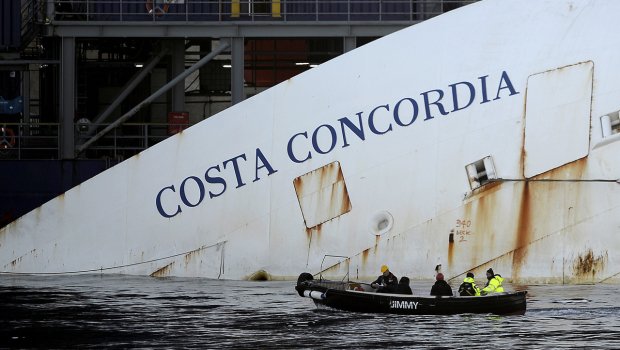
Almost a year ago, more than 3,000 people were relaxing aboard the opulent cruise liner Costa Concordia at the start of a week-long Mediterranean cruise. Today the ship is the subject of possibly the largest and most daunting marine salvage operation ever attempted.
On Friday 13 January 2012, Costa Concordia heeled over on to its side, with more than 4,000 people on board, just off the coast of the small Italian island of Giglio.
Thirty-two passengers and crew members died in the accident, which unfolded when Capt Francesco Schettino steered the ship too close to shore while trying to show it off to islanders, and hit a rock.
Pockmarked with rust smears, its once bright paintwork bleached by the sun, the hulk of the Costa Concordia makes a forlorn spectacle.
Winter storms have battered its exposed flanks, making the work of the 400-strong salvage team even more difficult.
It was originally planned that the vessel would be removed from Giglio by the spring of 2013. However, work is now expected to be complete “by the end of summer”.
Much of the work so far has been preparatory.
Appendages, steel cables and anchor chains have been welded to the hull by the salvage workers, who are working day and night to recover the 114,000-tonne metal bulk.
No operation on the scale of that to recover the Costa Concordia has ever been attempted. It is being carried out by salvage companies Titan and Micoperi, and will unfold in several stages.
The basic plan is to roll the ship upright and then refloat it using huge metal boxes, or caissons, welded to its sides.
The vessel, which still contains tons of rotting food, furniture, bedding and passengers’ belongings, will then be towed away intact to prevent damage to the environment.
To prepare for the rollover operation, divers have attached heavy steel cables to anchor the ship and prevent it slipping into deeper water.
Large steel plates will be positioned beneath the hull as support to prevent it breaking up while the operation is under way.

In December, the ship’s funnel was removed to allow better access to the ship.
Project director Franco Porcellacchia said: “This is a very delicate and unusual project. We have no reference here.
“At the moment, we are working on the preparation of the seabed so that the ship rotates properly. We’re using grout bags containing sand and cement to make an artificial seabed.”
With the ship stabilized, the rollover is expected to take two days, as it must be done painstakingly slowly to prevent further damage to the weakened hull.
A series of steel platforms is being positioned underneath to cradle the ship when it returns to its upright position.
Once upright, more caissons will be attached to the side that had been submerged, and the water in them will then be replaced with air to give buoyancy and allow the wreck to be towed away.
With the ship considered beyond economic repair, its final destination is expected to be a dry dock in Sicily, where it will be cut up.
Franco Porcellacchia said environmental risks were key concerns.
“Salvage teams do not have access to the inside, but we are working to prevent any substance from inside leaking. So far we have recorded no pollution and the situation is being constantly monitored by the authorities.
“The salvage is a joint venture [between Titan and Micoperi], but that contract is terminated when the ship is raised,” Franco Porcellacchia said.
“Dismantling it is another ball game.”
KEY EVENTS
- 13 January: Costa Concordia runs aground
- 28 January: Operation to remove fuel delayed due to bad weather
- 31 January: Search for bodies abandoned
- 12 February: Fuel removal operation finally begins
- 22 March: Five more bodies found in wreck
- 24 March: Fuel removal work completed
- 21 April: Salvage contract awarded to firms Titan Salvage and Micoperi
- 15 October: Captain Francesco Schettino appears at court inquiry
[youtube UQJmLJbviTo]
[youtube rur4SXtlTUE]